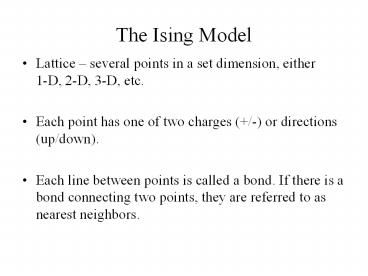The Ising Model - PowerPoint PPT Presentation
Title:
The Ising Model
Description:
The Ising Model Lattice several points in a set dimension, either 1-D, 2-D, 3-D, etc. Each point has one of two charges (+/-) or directions (up/down). – PowerPoint PPT presentation
Number of Views:70
Avg rating:3.0/5.0
Title: The Ising Model
1
The Ising Model
- Lattice several points in a set dimension,
either 1-D, 2-D, 3-D, etc. - Each point has one of two charges (/-) or
directions (up/down). - Each line between points is called a bond. If
there is a bond connecting two points, they are
referred to as nearest neighbors.
2
All of the red points are nearest neighbors to
the blue point. This is a 2-dimensional lattice
3
Hamiltonian Equation
- Calculates the total energy of a system
- Defined as H H(s) - ? E sisj - ?Jsi
lti,jgt
i
Where H total energy of the system s the
value assigned to a specific lattice site
(up/down or /-) s i and s j the value of the
spin at the specific lattice site, where s 1
if the spin is pointing up or s -1 if the spin
is pointing down Its important to understand
that for ? E sisj , the i and j in brackets (lti ,
jgt) means that s i s j is added up over all
possible nearest neighbor pairs. Since the
second summation is just for i, we can just add
up s i for lattice i. Values E and J are both
constants, where E strength of the s i and s j
interaction J additional interaction of the
individual spins with some external magnetic
field (i.e temperature)
4
1
-1
1
-1
1
- From our simplified Ising Model, we took the E
and J parameters out of the summations and set E
1 and J 0 - Now we can start calculating the Hamiltonian
equation - First, we need the summation of all the energies
of all the nearest neighbor pairs surrounding the
chosen lattice site (in red) - -E? sisj-J ?si -(1)(-1)(1) (-1)(1)
(-1)(1) (-1)(-1) - (0)-1-1-1-1 2
5
1
Now, we should flip the red point to a positive
1 to see if the total energy will decrease. If
the flip produces a lower energy, we will keep
the flip since the lattice favors a lower energy.
1
-1
1
1
-E? sisj-J ?si -(1)(1)(1) (1)(1) (1)(1)
(1)(-1) - (0)1111 -2 Since the total
energy decreased, the red point would flip to be
an up spin (positive one)































